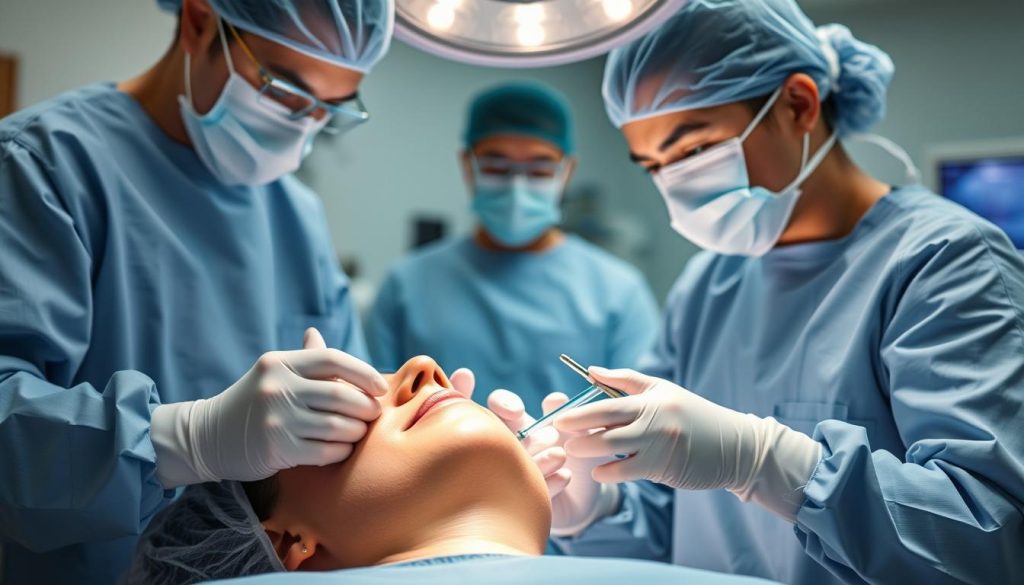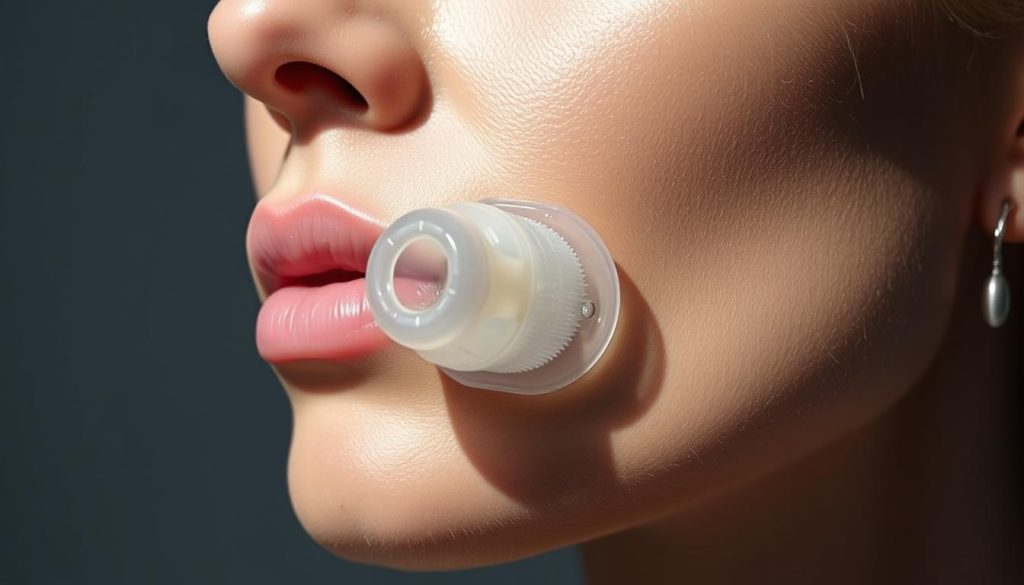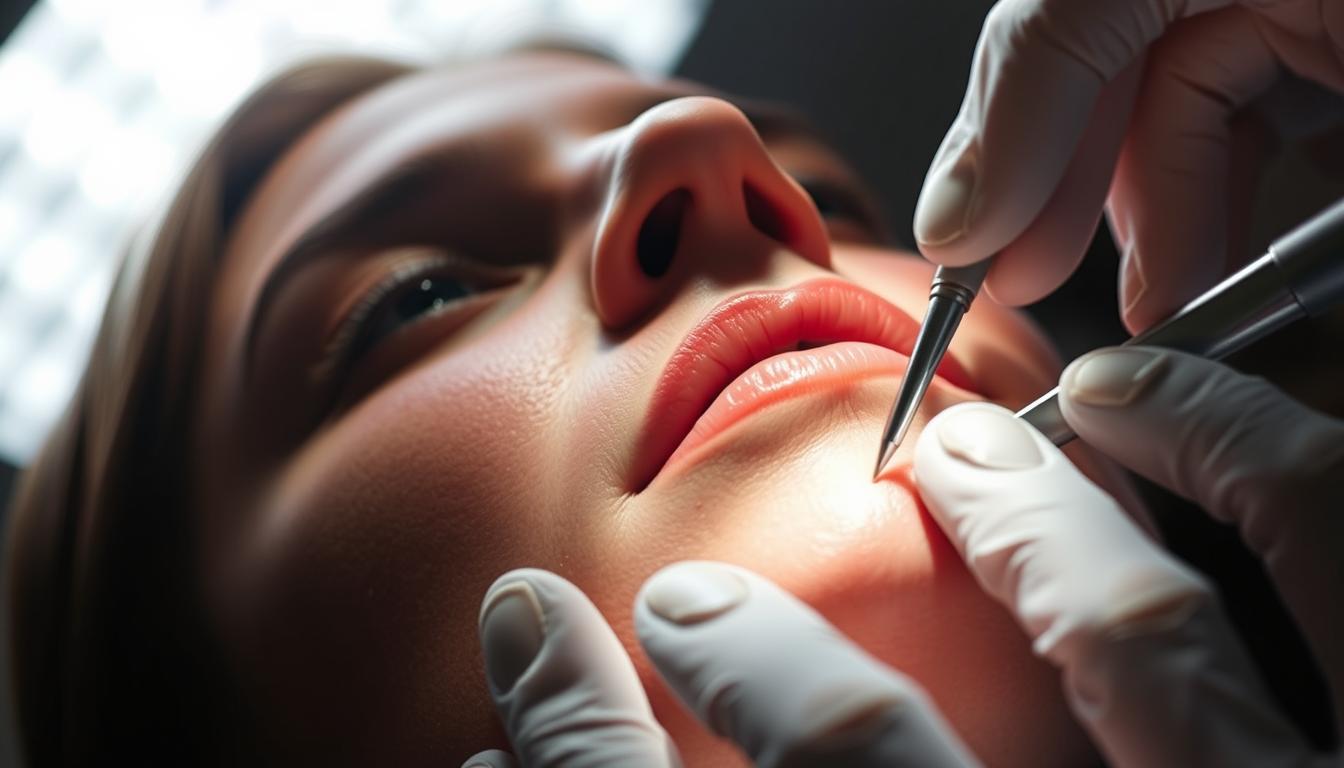Facial rejuvenation has become a significant concern for many individuals as they age. Facial augmentation and lift surgery offer a comprehensive solution to address both volume loss and sagging.
These surgical procedures can be performed separately or combined to achieve more dramatic results. Unlike temporary solutions, surgical facial enhancement offers long-lasting improvements to facial contours.
Modern plastic surgery techniques allow for customized approaches based on each patient’s unique facial structure and aesthetic goals.
Key Takeaways
- Facial augmentation and lift surgery address volume loss and sagging.
- These procedures can be performed separately or combined.
- Surgical facial enhancement offers long-lasting results.
- Customized approaches are available based on individual facial structures.
- Qualified surgeons with expertise in facial procedures can significantly impact one’s appearance and self-confidence.
What Is Facial Augmentation and Lift Surgery?

Facial augmentation and lift surgery combine to provide a comprehensive approach to facial rejuvenation. These procedures are designed to address various signs of aging, such as sagging skin, deep wrinkles, and loss of facial volume.
Common Types of Facial Augmentation Procedures
Facial augmentation procedures are tailored to individual needs and can include a variety of techniques to enhance facial features. Some common procedures include:
- Facial Implants: Used to enhance the shape and size of facial features such as cheeks, chin, and jawline.
- Dermal Fillers: Injectable fillers that restore lost volume, smooth out wrinkles, and enhance facial contours.
- Fat Transfer: A procedure that involves transferring fat from one part of the body to the face to restore volume and achieve a more youthful appearance.
Different Facial Lift Techniques
Facial lift techniques vary, offering different benefits and outcomes. Some of the most common techniques include:
- Traditional Facelift (Rhytidectomy): Addresses the lower face and neck by removing excess skin and tightening underlying tissues.
- Mid-Face Lift: Targets sagging in the cheek area and nasolabial folds.
- Brow Lift (Forehead Lift): Raises drooping eyebrows and reduces forehead wrinkles.
- Neck Lift: Addresses excess skin and fat in the neck area for a more defined jawline.
- Mini-Facelift Techniques: Use smaller incisions and provide more subtle results with shorter recovery times.
- Thread Lifts: A less invasive alternative that uses specialized sutures to lift facial tissues.
- SMAS (Superficial Musculoaponeurotic System) Facelift: Addresses deeper facial tissues for longer-lasting results.
Each of these techniques can be tailored to meet individual needs and preferences, offering a range of options for those seeking facial rejuvenation.
Benefits of Combining Facial Augmentation and Lift
The synergy between facial augmentation and lift surgery provides a powerful approach to addressing various signs of aging. By combining these procedures, individuals can achieve a more comprehensive facial rejuvenation.
Enhanced Facial Volume and Contour
Facial augmentation plays a crucial role in restoring lost volume and enhancing the facial contour. When combined with a lift procedure, it can effectively address the loss of facial fullness and sagging skin that occurs with aging.
- Replenishing lost volume in areas such as the cheeks and lips
- Enhancing facial contours to create a more defined and youthful appearance
- Combining augmentation with a lift to reposition descended facial tissues
Correction of Sagging Facial Features
Sagging facial features are a hallmark of the aging process, caused by gravity, loss of skin elasticity, and the effects of time on facial tissues. A facial lift procedure directly addresses these concerns by repositioning the facial tissues to their more youthful position on the facial skeleton.
- Removal of excess skin to eliminate jowls and other signs of facial aging
- Tightening of underlying facial muscles and tissues for longer-lasting results
- Strategic lift techniques to open up the eyes and define the jawline
By integrating facial augmentation with lift surgery, patients can enjoy a more refreshed and revitalized appearance, with results that look natural and are long-lasting.
Ideal Candidates for Facial Augmentation and Lift
To achieve the best results from facial augmentation and lift surgery, it’s essential to assess the suitability of candidates based on specific criteria.

Age and Skin Condition Considerations
When considering facial augmentation and lift surgery, age and skin condition play significant roles. Candidates typically range from their 40s to 60s, but this can vary based on individual factors such as skin elasticity and the extent of facial aging.
The condition of the skin, including its elasticity and the presence of deep wrinkles or sagging, is crucial in determining the potential success of the surgery.
Health Requirements and Expectations
Ideal candidates should be in good overall health without uncontrolled medical conditions such as hypertension, diabetes, or bleeding disorders.
- Candidates should be in good overall health without uncontrolled medical conditions like hypertension, diabetes, or bleeding disorders.
- A comprehensive medical history review is essential to identify any potential risk factors or contraindications for surgery.
- Patients taking certain medications or supplements may need to temporarily discontinue them before surgery to reduce bleeding risk.
- Realistic expectations about results, recovery time, and potential limitations of the procedures are crucial for patient satisfaction.
- Understanding that facial augmentation and lift surgery can improve appearance but not completely stop the aging process is important.
- Patients should be prepared for the possibility of revision procedures or maintenance treatments in the future.
- Psychological readiness for temporary changes in appearance during the healing process and patience with final results is necessary.
By carefully evaluating these factors, potential candidates can make informed decisions about undergoing facial augmentation and lift surgery, aligning with their aesthetic goals and health status.
The Consultation Process

A comprehensive consultation is the foundation of a successful facial augmentation and lift surgery, allowing the surgeon to tailor the procedure to the patient‘s needs.
What to Discuss With Your Surgeon
During the consultation, it’s essential to have an open and honest discussion with your surgeon about your goals and expectations. This is the time to ask questions and address any concerns you may have about the procedure.
- Research facial augmentation and lift procedures beforehand to have a basic understanding of the options available.
- Prepare a list of questions about the procedure, recovery, risks, and expected outcomes to ensure all your concerns are addressed.
- Bring a complete list of current medications, supplements, and any previous facial surgeries or treatments.
- Consider bringing photos of yourself when you were younger to help the surgeon understand your facial aging pattern.
- Be prepared to discuss your medical history honestly, including any conditions that might affect healing or increase surgical risks.
- Think about your specific goals and priorities for the procedure to help guide the surgical plan.
- Wear minimal or no makeup to the consultation so the surgeon can properly assess your facial features and skin condition.
- Consider bringing a trusted friend or family member for support and to help remember important information discussed.
Preparing for Your Consultation
To make the most out of your consultation, it’s crucial to be well-prepared. This includes doing your research, having a clear understanding of what you want to achieve, and being ready to discuss your medical history and any concerns you may have.
By being thoroughly prepared, you can ensure that your consultation is productive and that you get the most out of your meeting with the surgeon.
Understanding the Surgical Process of Augmentation and Lift
The surgical process of facial augmentation and lift involves several key steps that must be carefully planned and executed. This complex procedure requires a deep understanding of facial anatomy and a skilled surgeon to achieve the desired results.
Anesthesia and Procedure Duration
Facial augmentation and lift surgery is typically performed under general anesthesia or intravenous sedation to ensure patient comfort. The choice of anesthesia depends on the extent of the procedure and the patient’s overall health. The duration of the surgery can vary, but it usually takes between 1 to 3 hours to complete, depending on the complexity of the case and whether other procedures are being performed simultaneously.
Incision Techniques and Placement
The surgeon will carefully plan the incision sites to minimize visible scarring. For facial augmentation, incisions are often made in discreet locations, such as within the hairline or along the natural contours of the face. The placement of incisions is critical to achieving a natural-looking result while minimizing the risk of noticeable scars.

Implant Options and Materials
Facial implants are available in various materials, with medical-grade silicone being the most commonly used due to its biocompatibility and natural feel. Other implant materials include porous polyethylene (Medpor), which allows tissue ingrowth for stability, and ePTFE (Gore-Tex), known for its soft texture. Implants come in a range of standard sizes and shapes for different facial areas, including cheek, chin, and jawline implants.
Custom-designed facial implants can be created based on 3D imaging of the patient’s facial structure for optimal fit and results. Autologous options like fat transfer use the patient’s own tissues to create volume without the need for synthetic implants. The choice of implant material and design depends on the specific area being augmented, desired outcome, and surgeon preference.
Advances in implant technology have led to the development of options that feel and move more naturally with facial expressions, enhancing the overall outcome of facial augmentation procedures.
Recovery Timeline and Post-Operative Care
After undergoing facial augmentation and lift surgery, understanding the recovery timeline is crucial for optimal healing and results. The post-operative period is a critical phase that requires careful planning and adherence to the surgeon’s instructions.
Immediate Recovery Period (1-2 Weeks)
The initial recovery period is characterized by swelling, bruising, and discomfort. During this time, it’s essential to follow a regimen that promotes healing and minimizes complications. Patients are advised to rest, avoid strenuous activities, and apply cold compresses to reduce swelling.
By 2-3 weeks post-surgery, most visible bruising has resolved, and swelling has significantly decreased, although some residual swelling remains. Makeup can typically be worn after 10-14 days, helping to conceal any remaining bruising or redness.
Long-Term Healing and Results (2-6 Weeks)
As patients progress through the recovery timeline, they can usually return to light exercise and most normal activities by 3-4 weeks, with a gradual return to more strenuous activities by 6 weeks. Facial sensitivity, tightness, and occasional tingling sensations may persist for several weeks as nerves regenerate and tissues adapt to their new position.
Sun protection becomes extremely important during this period, as healing skin is more susceptible to sun damage and hyperpigmentation. Most patients are presentable for important social events by 3-4 weeks, though subtle swelling may still be present.
| Recovery Milestones | Timeframe |
|---|---|
| Most visible bruising resolved | 2-3 weeks |
| Return to light exercise and normal activities | 3-4 weeks |
| Return to strenuous activities | 6 weeks |
| Final results evolve | 3-6 months |
Final results continue to evolve over 3-6 months as all swelling resolves and tissues settle into their new position. Follow-up appointments during this period allow the surgeon to monitor long-term healing and address any concerns.
Potential Risks and Complications
Understanding the potential risks and complications of facial augmentation and lift surgery is essential for informed decision-making. As with any surgical procedure, there are risks involved that can impact the outcome and the patient’s recovery process.

Common Side Effects
Facial augmentation and lift surgery can result in several common side effects, including swelling, bruising, and temporary numbness. These effects are typically managed with medication and resolve on their own within a few weeks. However, it’s crucial for the patient to follow the surgeon‘s instructions to minimize these effects.
“The key to a smooth recovery is adhering to the post-operative care instructions provided by your surgeon,” emphasizes a leading plastic surgeon. “This includes managing pain effectively, attending follow-up appointments, and monitoring for any signs of complications.”
“Complications, although rare, can occur. Being aware of the signs and knowing when to seek help is vital for the patient’s safety and optimal outcomes.”
When to Contact Your Surgeon
It’s essential for patients to be aware of the signs that indicate a need for immediate medical attention. Some of these signs include:
- Excessive pain not controlled by prescribed medication.
- Significant asymmetry or sudden increase in swelling on one side of the face.
- Signs of infection, such as increased redness, warmth, pus, or fever over 100.4°F.
- Unusual drainage from incisions or opening of the wound.
- Changes in vision, severe headache, or difficulty breathing.
- Exposure of any implant material through the skin or inside the mouth.
- Persistent numbness or weakness in facial muscles beyond the expected recovery period.
Recognizing these signs early and contacting your surgeon promptly can mitigate risk and ensure a successful outcome. Any concerns about healing or results should be discussed with your surgeon rather than attempting self-diagnosis or treatment.
Cost Factors for Facial Augmentation and Lift Surgery

The financial investment required for facial augmentation and lift surgery is a critical consideration for potential patients. This complex procedure involves various cost factors that can significantly impact the overall expense.
Average Price Ranges
The cost of facial augmentation and lift surgery can vary widely depending on factors such as the surgeon’s fees, location, and the complexity of the procedure. On average, patients can expect to pay within a specific price range, which encompasses the surgery and related expenses.
Insurance and Financing Options
Facial augmentation and lift procedures are typically considered cosmetic and therefore not covered by health insurance unless performed for reconstructive purposes following trauma or disease. However, some patients may qualify for partial insurance coverage if the procedure addresses functional issues.
- Many plastic surgery practices offer financing options through medical credit companies like CareCredit or Alphaeon Credit.
- These financing plans often feature promotional periods with no interest if paid in full within a specified time frame, typically 6-24 months.
- Some practices offer in-house payment plans allowing patients to spread the cost over several months.
- Health Savings Accounts (HSAs) or Flexible Spending Accounts (FSAs) may be used for certain aspects of the surgery if deemed medically necessary.
It is essential for patients to thoroughly review financing terms, including interest rates and payment requirements, before committing to a payment plan.
Before and After: Setting Realistic Expectations
Achieving the desired outcome from facial augmentation and lift surgery requires a comprehensive understanding of what to expect before and after the procedure. Patients should be aware of the timeline for visible results and the factors that influence the longevity of the outcomes.
Timeline for Visible Results
The time it takes to see the final results of facial augmentation and lift surgery can vary. Initially, the face may appear swollen, and it may take several weeks for the swelling to subside and the implants to settle into their final position.
Generally, patients can expect to see significant improvements within a few months. Facial augmentation with implants typically provides permanent volume enhancement, although the natural aging process continues around the implants.
Maintenance and Long-Term Outcomes
To maintain the results of facial augmentation and lift surgery, several factors come into play. The longevity of the results can be influenced by lifestyle choices and post-operative care.
- Maintaining a stable weight helps preserve results, as significant weight fluctuations can affect facial volume and skin laxity.
- Sun protection is crucial for maintaining results and preventing further photoaging of the skin.
- Non-surgical treatments like Botox, fillers, or laser procedures may help extend and enhance surgical results.
- A healthy lifestyle, including proper nutrition, hydration, sleep, and avoiding smoking, contributes to longer-lasting results.
- Some patients choose to have minor revision procedures or “touch-ups” after several years to maintain their rejuvenated appearance.
- Regular follow-up with your plastic surgeon allows for monitoring of long-term results and timely intervention if needed.
| Factor | Influence on Results | Recommendation |
|---|---|---|
| Weight Stability | Significant weight fluctuations can affect facial volume and skin laxity. | Maintain a stable weight through a balanced diet and regular exercise. |
| Sun Protection | UV exposure can lead to further photoaging of the skin. | Use sunscreen with a high SPF, wear protective clothing, and avoid prolonged sun exposure. |
| Lifestyle Choices | A healthy lifestyle contributes to longer-lasting results. | Focus on proper nutrition, hydration, sleep, and avoid smoking. |
By understanding the factors that influence the outcomes of facial augmentation and lift surgery and taking steps to maintain a healthy lifestyle, patients can enjoy long-lasting results. It’s also important to have realistic expectations about the time it takes to see the final results and the potential need for future touch-ups.
Taking the Next Step Toward Facial Rejuvenation
Embarking on a facial rejuvenation journey requires careful consideration and planning. It begins with scheduling a consultation with a board-certified plastic surgeon specializing in facial procedures. This initial step is crucial in understanding the possibilities and limitations of facial augmentation and lift surgery.
To make an informed decision, it’s essential to research potential surgeons’ credentials, review before and after galleries, and read patient reviews. This helps identify qualified professionals who can help achieve your goals. Preparing a list of questions and concerns before your consultation ensures that you gather all the necessary information.
- Consider timing factors such as work obligations, social events, and recovery time to plan the optimal schedule for your procedure.
- Multiple consultations with different surgeons may provide valuable perspectives and increase confidence in your final choice.
- Understanding that facial rejuvenation is a personal journey with emotional as well as physical aspects helps create appropriate expectations.
- Take time to reflect on your motivations and goals to ensure that surgery is the right choice for your specific situation.
Discussing your plans with supportive friends or family members can provide valuable emotional support throughout the process. By taking these steps, you can make an informed decision and achieve the desired outcome from your facial augmentation and lift surgery.
FAQ
What is the difference between breast implants and breast enhancement?
Breast implants are a type of breast enhancement that involves surgically placing implants to increase breast size or restore breast volume. Breast enhancement can also include other procedures, such as a breast lift, to improve the overall appearance of the breasts.
How long does it take to recover from breast implant surgery?
The recovery time for breast implant surgery typically takes several weeks. Most patients can return to their normal activities within 1-2 weeks, but it may take 2-6 weeks for the breasts to fully heal and settle into their new shape.
What are the risks associated with breast implant surgery?
As with any surgical procedure, breast implant surgery carries risks, including scarring, infection, and implant rupture. It’s essential to discuss these risks with a qualified surgeon to understand the potential complications and how to minimize them.
Can I get breast implants if I’ve had a pregnancy or breastfeeding?
Yes, women who have had a pregnancy or breastfeeding can still be candidates for breast implants. However, it’s crucial to wait until after pregnancy and breastfeeding are complete, as these can affect breast tissue and implant placement.
How do I choose the right implant size and type for my body?
Choosing the right implant size and type depends on several factors, including your body type, breast tissue, and personal preferences. A qualified surgeon can help you determine the best implant options for your individual needs and goals.
What is the average cost of breast implant surgery?
The cost of breast implant surgery varies depending on factors such as the type of implants, surgeon’s fees, and location. On average, the cost can range from ,000 to ,000 or more, including the surgeon’s fee, anesthesia, and facility costs.
Will I need to replace my breast implants in the future?
Breast implants are not considered lifetime devices and may need to be replaced at some point. The lifetime of breast implants varies depending on factors such as the type of implant, individual factors, and wear and tear.
